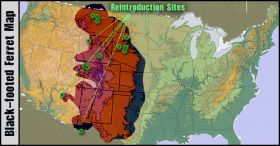Black-footed Ferret
Mustela nigripes
The Black-footed Ferret is one of the great success stories of endangered animal reintroduction in the United States. While they may not have recovered to the numbers that will sustain an unaided healthy population, their story brings great hope. Yet, without our continued help they may very well become extinct.
A Quick Background
Black-footed ferrets were thought to be extinct in the US when the last studied population vanished from South Dakota in 1974. It wasn’t until they were accidentally discovered in Meeteetse, Wyoming, in 1981 by a cattle dog named Shep, that they were put back on the radar of the US Fish and Wildlife Service and the recovery program started again.
Why are Black-footed Ferrets endangered?
On a very basic level, these small ferrets are endangered because they have lost their once, vast habitat. Black-footed ferrets have specialized on eating prairie dogs and without the land for vast numbers of prairie dogs, there are not ferrets. As it turns out, it wasn’t long ago that prairie dogs were the target of extermination efforts by farmers. The US government even supported the poisoning of large numbers of prairie dogs. The ferrets couldn’t survive this onslaught and they were thought to have gone extinct in the US. Fortunately, one small dog in Wyoming found a single black-footed ferret. Teams went in to Meeteetse, WY, and ended up finding about 130 individuals.
How many Black-footed Ferrets are left in the wild?
It is believed that there were only 18 ferrets left in the entire country when that population was discovered in Meeteetse. Those individuals were trapped, and a breeding program was set up and run from a center in Northern Colorado.
Today there are 18 reintroduction sites in several states across the plains states. It is estimated that about 1,000 individuals exist in the wild, with more being reintroduced every year. (Read more about Black-footed ferret reintroduction programs.)
Who is helping the Black-footed Ferrets?
The US Fish and Wildlife Service has set up the Black-footed Ferret Conservation Center to organize these reintroduction efforts. They have bred over 5,500 ferrets and reintroduced roughly half of those back into their native range. Leading the center is biologist Paul Marinari.
Online Videos about the Black-footed Ferrets
This video from National Geographic shows some of the field work being conducted on Black-footed ferrets by Earthwatch Teams:
Related Topics
The Black-footed Ferret is one of the great success stories of endangered animal reintroduction in the United States. While they may not have recovered to the numbers that will sustain an unaided healthy population, their story brings great hope. Yet, without our continued help they may very well become extinct.
A Quick Background
Black-footed ferrets were thought to be extinct in the US when the last studied population vanished from South Dakota in 1974. It wasn’t until they were accidentally discovered in Meeteetse, Wyoming, in 1981 by a cattle dog named Shep, that they were put back on the radar of the US Fish and Wildlife Service and the recovery program started again.
Why are Black-footed Ferrets endangered?
On a very basic level, these small ferrets are endangered because they have lost their once, vast habitat. Black-footed ferrets have specialized on eating prairie dogs and without the land for vast numbers of prairie dogs, there are not ferrets. As it turns out, it wasn’t long ago that prairie dogs were the target of extermination efforts by farmers. The US government even supported the poisoning of large numbers of prairie dogs. The ferrets couldn’t survive this onslaught and they were thought to have gone extinct in the US. Fortunately, one small dog in Wyoming found a single black-footed ferret. Teams went in to Meeteetse, WY, and ended up finding about 130 individuals.
How many Black-footed Ferrets are left in the wild?
It is believed that there were only 18 ferrets left in the entire country when that population was discovered in Meeteetse. Those individuals were trapped, and a breeding program was set up and run from a center in Northern Colorado.
Today there are 18 reintroduction sites in several states across the plains states. It is estimated that about 1,000 individuals exist in the wild, with more being reintroduced every year. (Read more about Black-footed ferret reintroduction programs.)
Who is helping the Black-footed Ferrets?
The US Fish and Wildlife Service has set up the Black-footed Ferret Conservation Center to organize these reintroduction efforts. They have bred over 5,500 ferrets and reintroduced roughly half of those back into their native range. Leading the center is biologist Paul Marinari.
Online Videos about the Black-footed Ferrets
This video from National Geographic shows some of the field work being conducted on Black-footed ferrets by Earthwatch Teams:

































































































